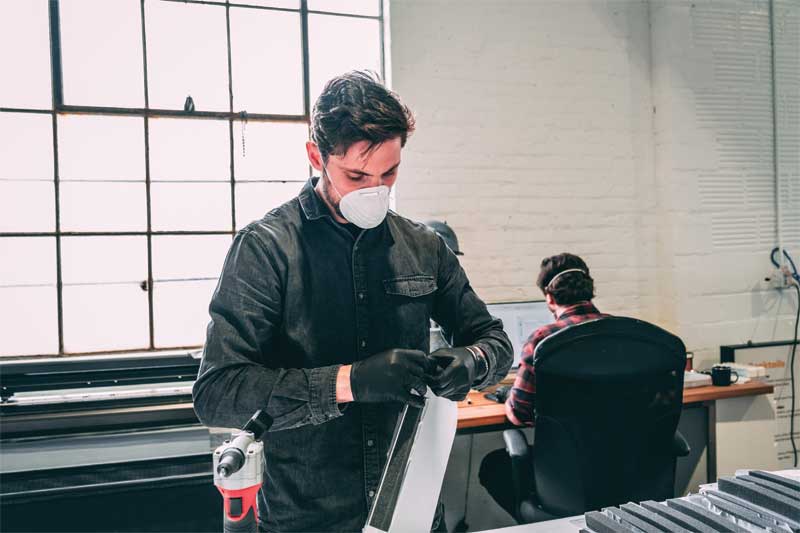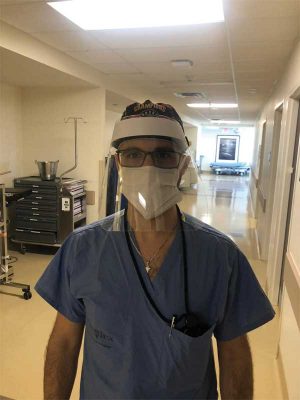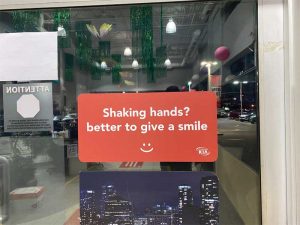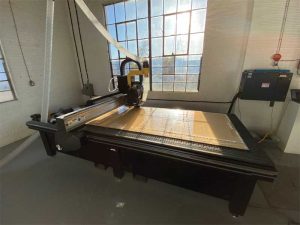Shifting gears: Ontario sign shop pivots business to ease the burden of COVID-19
by | 4 November 2020 4:18 pm
By Sonia Yooshing
 [1]
[1]Since the global pandemic started, many shops have had to shut down business, some even permanently. Fortunately, some companies were able to shift gears to develop and distribute personal protective equipment (PPE) and other medical supplies to aid in the response to COVID-19. From producing social distancing graphics to manufacturing protective face shields, hand sanitizer, and garments for frontline workers, several sign shops have retooled their manufacturing facilities to provide critical protective equipment for medical workers amid looming supply shortages and help in the fight against the virus.
Sign Media Canada recently spoke with Kenneth Tschernow, owner of North Design Build in Hamilton, Ont., to learn more how the shop was able to pivot its business and supply essential items to ease the burden during these unprecedented times.
 [2]
[2]Sign Media Canada (SMC): What motivated you and the staff to produce PPE, social distancing graphics, and plexiglass barriers?
Kenneth Tschernow (KT): During the COVID-19 economic shutdown, we evaluated whether or not we were an essential business. When the Government of Canada sent out a call to action requesting manufacturers to help combat the pandemic, we knew right away this was something we could assist with. With protective equipment in such short supply, we realized PPE and other infection-prevention products were really the only items we should be producing at the time.
We used our Multicam Apex1R computer numerical control (CNC) router to prototype a high-performance face shield for frontline workers. Through a fundraising campaign, we were able to raise more than $16,000, which allowed us to donate thousands of face shields to workers in need of proper protection.
SMC: What type of PPE is the shop producing? Do you install these on-site?
KT: The shop is currently manufacturing a wide range of products, including polycarbonate (a lightweight, high-performance plastic) face shields, plexiglass barriers, sneeze guards, and social distancing graphics. We also install everything we produce across the Greater Toronto and Hamilton Area (GTHA).
SMC: What was the process for making PPE?
KT: Diving into the medical industry was a bit of a learning curve. I called some friends who are involved with surgical sales and they helped get North Medical Group, a division of North Design Build, off the ground. Having a sales team in the medical industry allowed us to get our face shields directly into the hands of doctors, nurses, and several health care professionals across the province. We applied for and received a medical-device establishment licence within two weeks. This has enabled us to manufacture and distribute these products across the country. We now plan on developing and manufacturing even more types of PPE.
 [3]
[3]SMC: How was the manufacturing facility set up to produce these products?
KT: Fortunately, we already had the equipment in place to produce these products. We have a CNC router that we use to cut polycarbonate and acrylic while the HP Latex 115 printer and cutter helps us produce vinyl labels and large-format signage.
SMC: How did the materials supply chain differ from the traditional products you used earlier? With many companies/industries manufacturing PPE, was it difficult to find suppliers?
KT: Much to my surprise, our regular supply of plexiglass and polycarbonate was completely run dry. The lead times for plastic supply were between four and eight weeks, which was certainly not going to work for us. We scoured the internet to find possible sources and, finally, found what we needed. Suppliers did not have sufficient stock, often selling out of products the same day they became available. I remember being placed on hold while the sales representative negotiated with a buyer on another line who was ready to buy their entire stock. With the help of Tribe Medical Group, a Canadian distributor of Arthrex and LifeNet products, we were able to secure enough polycarbonate to produce thousands of face shields.
SMC: Are you currently producing traditional signage? If yes, how do you balance the workload?
KT: Yes, we are also producing traditional signage. It has been difficult to balance the workload indeed. At first, we were relying on volunteers to produce face shields. With sales at an all-time low, we could not justify any new hires and were forced to lay off a few staff members. Slowly, things started to turn around and, by May, we were able to employ those volunteers, creating more part-time opportunities within the company. That said, we often find ourselves working longer hours, but we are very grateful to come out of this crisis on a positive upswing.
 [4]
[4]SMC: What were some of the challenges involved and how did you overcome them?
KT: Developing a face shield that is comfortable and functional while conforming to the Government of Canada’s material recommendations was the real challenge. We overcame this by launching a feedback campaign, which encouraged all end-users to submit their comments, complaints, and recommendations. This data along with a few healthcare practitioners’ napkin sketches helped us further refine our design, making it a true one-size-fits-all, useful, and practical product.
SMC: Do you see PPE as a part of your product offerings going forward?
KT: Definitely! Our intentions with this product line go long term. What started out as an initiative to give back has evolved into a new business venture. We have started selling our PPE products on the North Medical Group website. These items offer a reliable revenue stream. We now have the opportunity to get creative and produce new, functional products in Canada.
- [Image]: https://www.signmedia.ca/wp-content/uploads/2020/11/IMG_5238.jpg
- [Image]: https://www.signmedia.ca/wp-content/uploads/2020/11/1.jpg
- [Image]: https://www.signmedia.ca/wp-content/uploads/2020/11/IMG_0204.jpg
- [Image]: https://www.signmedia.ca/wp-content/uploads/2020/11/IMG_0462.jpg
Source URL: https://www.signmedia.ca/shifting-gears-ontario-sign-shop-pivots-business-to-ease-the-burden-of-covid-19/